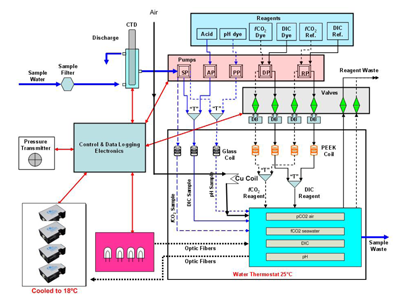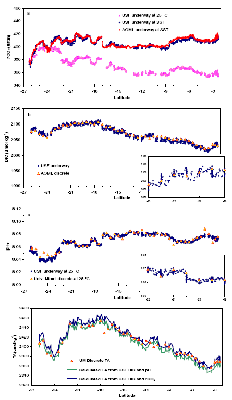U.S. Geological Survey Data Series 535A
Measurements of four seawater inorganic carbon system parameters - pH, fugacity or partial pressure of carbon dioxide (fCO2 or pCO2, respectively), total dissolved inorganic carbon (DIC), and total alkalinity (TA) - are essential for carbon cycle investigations on both global and local scales. Both observational and modeling efforts rely on high-quality inorganic carbon data from field measurements. Extensive efforts have been devoted to improving methodologies and instruments for determination of carbon parameters in seawater. In conventional methodologies, the four core parameters of the seawater inorganic carbon system are measured using diverse instrumentation (for example, potentiometry, spectrophotometry, gas chromatography, nondispersive infrared analysis, and coulometry). It is highly desirable, however, for all four parameters to be measured simultaneously and continuously with high temporal resolution and with high precision and accuracy. Among all available methodologies for measurements of inorganic carbon species in seawater, spectrophotometric methods are especially promising because they can simultaneously measure multiple parameters at relatively low cost. Moreover, spectrophotometric methods have many advantages for measuring inorganic carbon species in seawater: high sensitivity, good stability and selectivity, simplicity, and low rates of sample and reagent consumption. The available spectrophotometric methodologies developed over years for measurements of inorganic carbon parameters were engineered into a single system that is intended for high-resolution underway monitoring onboard research vessels. The MICA was designed as an autonomous multiple parameter flow-through system for simultaneous measurement of surface seawater TC, pH, and fCO2.

[Abbreviations: mL, milliliter; μL, microliter; h, hour; min, minute; μatm, microatmospheres; μmol/kg, micromoles per kilogram]
| fCO2 Channel | DIC Channel | pH channel | |
| Optical cell | Teflon AF 2400 LCW sealed in a PEEK cell | Teflon AF 2400 LCW sealed in a PEEK cell | PEEK rod with borehole |
| Indicator | Phenol red | Bromocresol purple | Thymol blue |
| Reagent consumption | 13 mL/hr | 13 mL/hr | 10 μL/min indicator |
| Calibration | Against standard CO2 gases | Against certified reference material (CRM) | Established previously; no field calibration is required |
| Equilibration time | 6 min - first sample 2 min - subsequent sample | 6 min - first sample 2 min - subsequent sample | Instant |
| Sampling frequency | 7 readings per hour | 7 readings per hour | 7 readings per hour |
| Field precision | ±0.9 μatm | ±2.4 μmol/kg | ±0.0008 pH units |
All of the measurements are based on spectrophotometric determinations of solution pH at multiple wavelengths using sulfonephthalein indicators (fig. 1 and table 1). The pH and TA optical cells are machined from PEEK polymer rod, and have a 15-cm optical pathlength. The fCO2 and DIC optical cells consist of Teflon AF 2400 (DuPont) capillary tubing sealed within a borehole also machined from PEEK. The Teflon AF tubing, filled with a standard indicator solution that has a fixed total alkalinity, forms a liquid core waveguide (LCW). The LCW functions as both a long pathlength (15 cm) optical cell and a membrane that equilibrates the internal standard solution with either external air (providing air pCO2 measurements), seawater (providing seawater fCO2 measurements), or acidified seawater (providing DIC measurements). Both pCO2 and DIC are then determined by measuring the pH of the internal solution. The MICA system makes repetitive observations with measurement frequencies of seven samples per
hour. Measurement precisions in the field are ±0.0008 units for pH, ±0.9 μatm for pCO2, and ±2.4 μmol kg-1 for DIC. These precisions are close to those obtained with conventional methods in the laboratory (fig. 2).

[Abbreviations: UM, University of Miami; USF, University of South Florida; AOML, Atlantic Oceanographic and Meteorological Laboratory; μatm, microatmospheres; μmol kg-1, micromoles per kilogram]